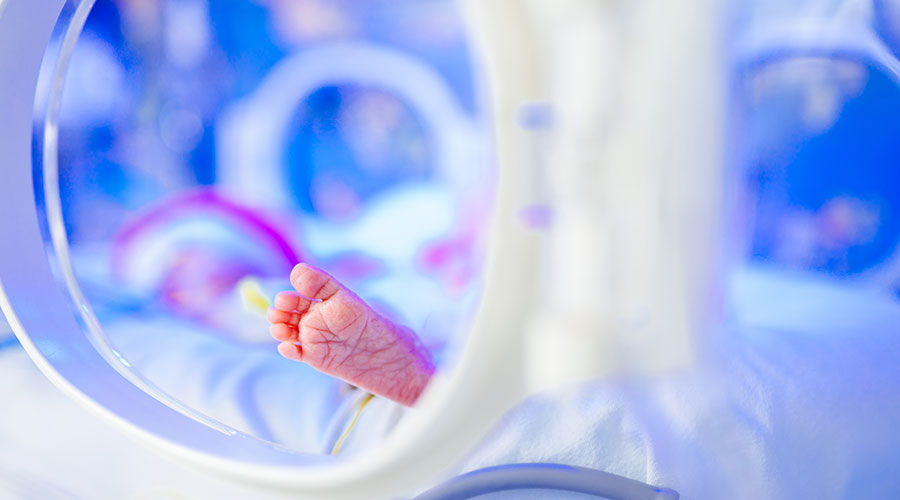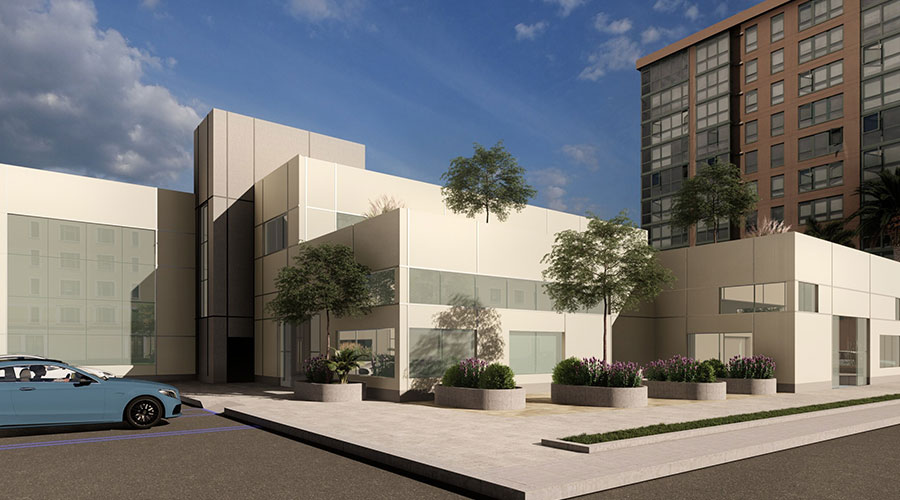I greet the security officer at the main entrance of SSM Health St. Mary’s Hospital in Madison, Wisconsin, handing him the badge that I keep pinned to my winter coat. After the usual small talk, he hands me my visitor pass, and I stick it to the back of my badge on top of the others I have accumulated in the weeks since my son was born. I take a deep breath and begin the long walk to the neonatal intensive care unit (NICU).
At St. Mary’s, the NICU can see up to 400 babies each year, all with varying different levels of care. Parents must get buzzed into the unit and immediately scrub in before they step foot in their child’s room. Unlike traditional depictions, each baby has their own room in this hospital’s NICU, equipped with a crib, two reclining chairs for parents, a sink, a mini fridge for breastmilk storage and a privacy curtain for nursing mothers. A noise-level monitoring system is affixed to the wall in the shape of an ear flashes green, yellow and red to alert parents if they are being too loud. While most areas of a hospital are hustling and bustling, this area is so quiet, you can almost hear the whispers of prayers from parents visiting their newborns.
“They are the most susceptible patients,” says Greg Hatzinger, power plant manager and facilities maintenance manager at SSM Health St. Mary’s Hospital. “I think they are the highest acuity and the ones that we would look out for the most simply because of their age. (NICU patients) are just so fragile.”
Babies can be sent to the NICU for numerous reasons, including premature birth, low birth weight, blood sugar issues, breathing issues, infections and multiple births, such as twins. Right from birth, these little humans have a compromised immune system, so everything is taken so much more seriously, especially infection control.
“All the air that goes into the NICU is all HEPA filtered,” Hatzinger says. “We also have UV lights within the area that serve a particular unit. It’s just as pure air as we can basically get. We do preventive maintenance on that unit about every three months, and it’s continuously monitored through our building automation system. We do everything that we possibly can to make that as clean an environment as it can be.”
Part of the hospital’s preventive maintenance program involves testing the room’s air flow semi-annually and changing the filters on the air units every three months. UV bulbs also are changed annually even if they are not burned out to provide the cleanest possible air for the infants.
Along with this effort, though, is the importance of hand hygiene, something that was well implemented at the hospital before the COVID-19 pandemic. Anytime a hospital employee walks in and out of any patient room, they must scrub and disinfect their hands.
“It’s not something you will notice at first, but the next time you go to a hospital, you will see it,” says Dan Wagner, manager of plant operations and maintenance at SSM Health St. Mary’s Hospital. “It’s a focus point for us. We bring it up in meetings. There’s always a reminder to do your proper hand hygiene.”
Working together
Collaboration is common at the hospital and not just for medical diagnosis. Every morning, all employees participate in a tiered escalation meeting that informs everyone of what’s going on in certain departments and if construction is occurring, Wagner says.
“There’s multiple meetings during the week on everything from what we can do to make [the hospital] better to what needs to be fixed,” Wagner says. “It all depends on the situation and the day. We are constantly in communication with one another.”
The tiered escalation process starts at the local level. When an issue arises, administrators roll it up to the regional tiered level and continue as needed. This process allows best practices to be shared systemwide, and managers can easily access new strategies.
“We also have a room refresher program that our teams collaborate on to touch up on patient rooms,” Wagner says. “When it’s empty, we do anything that needs preventive maintenance — replace ceiling tiles, put on a coat of new paint, fix holes in the walls. The maintenance team also takes a look at the air quality. We look at literally everything in that room and do everything we can to refresh and repair it.”
The responsibility doesn’t entirely fall on the maintenance team. When the environmental services department is disinfecting and cleaning the room after a patient is discharged, they will also see if anything needs to be repaired before a new patient arrives.
“We have a very robust work order system,” Hatzinger says. “Any nurse that sees any problem with a room can put a worker order in for maintenance, and we’ll come and look at the issue at any time. We are staffed 24/7 to take care of those types of issues.”
Even with multiple sets of eyes on a room, the maintenance team goes through a strict training regimen before any new staff member steps foot in a patient room. All new hires have check-off sheets where that must be qualified and signed off on before they’re allowed to work in any room, including NICU rooms, Hatzinger says.
“Some of the things they are trained on is when to replace a heating valve or when you can or cannot take out a ceiling tile,” Hatzinger says. “There’s quite a few things they have to be signed off on prior to going into a room. Even going back to hand hygiene, we go over everything in order to keep patients safe.”
Emergency preparedness
The maintenance team at SSM Health St. Mary’s - Madison is no stranger to tumultuous weather patterns. They are from Wisconsin, after all. One second the skies could be clear, and the next it could be snowing. Then a few hours later, it could be raining. One February evening this year, the city sounded a tornado warning. Working staff members had to follow extreme weather protocol until given the all-clear sign.
“We have four emergency generators,” Hatzinger says. “In the event of any type of outage, we are capable of supplying not only emergency power but normal power to the hospital. We have enough fuel on hand to last at least 96 hours without having to refuel. We also have an emergency well in the event that the city water goes out. Through the power plant, we can have the hospital stand alone from the city services and continue to provide the exact same services.”
The hospital has over one million square feet. It has three incoming utility lines, so if it was to lose one utility line, it would automatically transfer within three seconds to another utility line before having to go to the generator.
Extreme weather scenarios aren’t the only things the hospital prepares for. The hospital takes security seriously so that no patient or staff member is compromised in any way.
Anyone who enters the hospital must check in with security before they are allowed to go to an appointment or visit loved ones. Meanwhile, NICU parents wear badges that identify them and must get buzzed into the ward. Among the wires and machines, the babies are hooked up to is a band that notifies personnel if they are removed from the wing.
“The security system that we have for infants is tested monthly with an actual band that we wrap around our fingers to simulate a baby’s arm or leg,” Wagner explains. “We go off and test all the doors to make sure they magnetize locked when that band gets near them.”
While the security system is inspected annually, maintenance also checks the doors in the NICU monthly.
“That is a system we just take very seriously,” Wagner says. “We don’t joke around when something needs to be fixed. We call right away and get somebody to fix whatever problem there is. If something were to go down, security would come and post a person up there until we could get that particular part or system corrected.”
The hospital also conducts regular infant abduction drills. Hatzinger says he has seen people running out of their offices in order to ensure that every door and elevator is guarded, and that people are securing parking ramps.
“It’s just phenomenal how many people respond to that drill,” he says.
Constant care
It’s a long walk from the NICU to where my car is in the parking lot. An extended stay in the hospital was never my plan as a first-time parent. It’s stressful, it’s scary, and it’s painful having to leave my baby behind every single day. By the time I reach the main entrance, the night shift security guard is on duty, and I give him a nod goodbye. A few days later when we are discharged, he congratulates us.
Doctors and nurses get a lot, if not most, of the credit for keeping patients safe and healthy, but many other people also strive to provide the best possible care for all patients. Behind the scenes, the facilities team works all the time to ensure the hospital achieves the highest standards. They paint walls, change filters and quite literally keep the lights on. They are the backbone of healthcare facilities and the reason they continue to operate. Without them, patients would not receive the best possible care. For them, we should be so grateful.
Mackenna Moralez is the associate editor for the facilities market.

 UF Health Hospitals Rely on Green Globes to Realize Their Full Potential
UF Health Hospitals Rely on Green Globes to Realize Their Full Potential How Healthcare Facilities Can Be Truly Disaster-Resilient
How Healthcare Facilities Can Be Truly Disaster-Resilient TriasMD Breaks Ground on DISC Surgery Center for San Fernando Valley
TriasMD Breaks Ground on DISC Surgery Center for San Fernando Valley Bigfork Valley Hospital Falls Victim to Data Breach
Bigfork Valley Hospital Falls Victim to Data Breach AI-Driven Facilities: Strategic Planning and Cost Management
AI-Driven Facilities: Strategic Planning and Cost Management